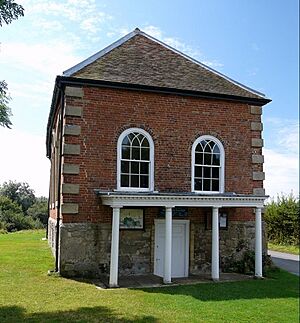Newtown Old Town Hall facts for kids
Quick facts for kids Newtown Old Town Hall |
|
|---|---|

Newtown Old Town Hall
|
|
| Location | Town Lane, Newtown |
| Built | 1699 |
| Architectural style(s) | Tudor style |
|
Listed Building – Grade II*
|
|
| Official name: Newtown Town Hall | |
| Designated | 18 January 1967 |
| Reference no. | 1209336 |
| Lua error in Module:Location_map at line 420: attempt to index field 'wikibase' (a nil value). | |
The Old Town Hall in Newtown, Isle of Wight, England, is a historic building that once played a big role in the town's life. It's located on Town Lane and is now a popular place for visitors. This special building is protected as a Grade II* listed building, which means it's very important and needs to be preserved. Even though Newtown is now a small village, its Old Town Hall is looked after by the National Trust, an organization that helps protect historic places and natural beauty.
Contents
The Story of Newtown Old Town Hall
Newtown started as a busy trading town and had special rights as a "borough" in the 1300s. However, it was badly damaged by a French attack in 1377 and struggled to get back on its feet. To help the town grow again, Queen Elizabeth I gave Newtown the right to send two people to Parliament in 1584. Parliament is the group that makes laws for the country.
Why a Town Hall Was Needed
In the late 1600s, the town's leaders, including the mayor and other important people called "burgesses," decided they needed a proper town hall. This building would allow them to use their special rights. For example, they could hold important dinners where they would choose who would represent Newtown in Parliament.
Building the Old Town Hall
The new building was designed in the Tudor style, which was popular back then. It was built using red bricks and finished around 1699. The front of the building, facing Town Lane, was designed to be perfectly balanced. It had a doorway on the ground floor and two round-topped windows on the first floor.
The back of the building had a doorway on the first floor, reached by an outside stone staircase. Inside, the most important rooms were the council chamber, where decisions were made, and the mayor's parlour, a special room for the mayor.
Changes and Challenges
Many important people were chosen as Members of Parliament in this town hall. One famous person was George Canning, who later became the Prime Minister in 1806. In 1813, a fancy entrance called a "portico" was added to the building. It had four columns supporting a decorative roof.
Newtown had a very small number of voters, and just three powerful families controlled who was elected. Because of this, the UK Parliament called it a "rotten borough." This meant it was unfair because a few people had too much power. In 1832, a new law called the Reform Act 1832 took away Newtown's right to elect Members of Parliament. The town council, which had already stopped working well, was officially closed down in 1883.
Saving the Old Town Hall
After many years of being neglected and falling apart, the building was finally repaired in 1933. A special architect named John Eric Miers Macgregor, who was an expert in saving old buildings, helped fix the damaged structure.
The money for these repairs came from a mysterious group called Ferguson's Gang. This group was made up of young, anonymous women who gave the Newtown Old Town Hall to the National Trust. They also arranged for it to be used as a Youth Hostel for fifteen years. Today, there's an exhibition inside the building that tells the story of Ferguson's Gang. The Old Town Hall is now a local tourist attraction, open to the public during the summer months.


